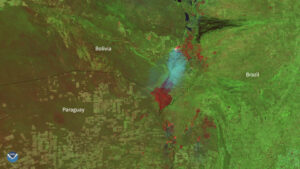NOAA and Google to apply machine learning to satellite data
By Debra Werner

SAN FRANCISCO – The National Oceanic and Atmospheric Administration announced an agreement Oct. 27 with Google Cloud to explore the benefits of artificial intelligence and machine learning to enhance the agency’s use of satellite and environmental data.
Under the three-year Other Transaction Authority (OTA) agreement, NOAA’s National Environmental Satellite, Data and Information Service and Google Cloud will conduct pilot projects to explore ways artificial intelligence and machine learning can “amplify NOAA’s environmental monitoring, weather forecasting, climate research and technical innovation,” according to a NOAA news release. NOAA did not disclose the value of the OTA.
“Strengthening NOAA’s data processing through the use of big data, artificial intelligence, machine learning and other advanced analytical approaches is critical for maintaining and enhancing the performance of our systems in support of public safety and the economy,” Acting NOAA Administrator Neil Jacobs said in a statement. “I am excited to utilize new authorities granted to NOAA to pursue cutting-edge technologies that will enhance our mission and better protect lives and property.”
NOAA captures troves of environmental data and imagery from its current constellation of weather satellites and its future constellation is likely to gather far more. NOAA officials often say that one of their most pressing challenges is extracting valuable information and insight from the flood of data.
“Advances in IT systems, cloud technology, artificial intelligence and machine learning have made it possible and profitable to accelerate the delivery of data,” NOAA Assistant Administrator Steve Volz said during a recent SpaceNews webinar. “We’re revising and restructuring our IT systems to make that possible. Our objective is that within approximately 10 years to have all datasets available for rapid dissemination and real-time processing in a common cloud framework to all of our users in the world.”
Initially, NOAA and Google will develop small-scale artificial intelligence and machine learning systems related to specific areas like weather forecasting. If that work is successful, NOAA and Google Cloud will create full-scale prototypes for operational use.
The work planned under the OTA “has the potential to be a significant leap in NOAA’s ability to leverage the enormous volume and diversity of environmental data in order to enhance prediction, including for extreme weather events such as hurricanes and tornadoes,” according to the news release.
Mike Daniels, Google Cloud Global Public Sector vice president, said in a statement, “Our goal is to increase scientific impact, and improve the efficiency and effectiveness of environmental and satellite data by leveraging Google Cloud’s infrastructure and artificial intelligence/machine learning know-how. All this will help improve weather forecasting, research and unlock innovation.”
Congress provided NOAA with authority to enter OTA agreements, which are more flexible than contracts that must follow voluminous federal acquisition regulations.
“We’re looking at how we can use that [OTA authority] to speed time to target, and in some cases work with companies that aren’t used to doing U.S. government contracts,” Vanessa Griffin, director of the Office of Systems Architecture and Advanced Planning in NOAA’s National Environmental Satellite, Data and Information Service, said during a recent SpaceNews webinar. So we definitely will be using our OTA authority. We’ll be leveraging that at every opportunity that we can.”
October 27, 2020 at 10:10PM
via SpaceNews read more...

Post a Comment